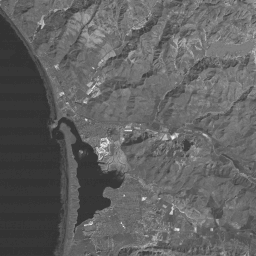 [an error occurred while processing this directive]
[an error occurred while processing this directive]
 [an error occurred while processing this directive]
[an error occurred while processing this directive]

Ratioing
Another image manipulation technique is known as ratioing. For each pixel, the
DN value of any one band are divided by the value of another
band. This quotient yields a new set of numbers that may range
from 0 = 0/1 to 255 = (255/1) but the majority will be fractional
(decimal) values between 0 and typically 2 - 3 (e.g., 82/51 = 1.6078...;
114/177 = 0.6440...). These can be rescaled to provide a gray
tones image in which 16 or 256 levels are attained depending on
the computer display limits. Three pairs of ratio images can be
co-registered and projected as color composites. Both in individual
ratio images and in these composites certain ground features tend
to be highlighted based on unusual or anomalous ratio values.
For example, an ore deposit may be weathered or altered so that
a diagnostic surface staining, called gossan, develops; this stain
consists of hydrated iron oxide (rust) that is normally yellow-brown.
In band 3, this material reflects strongly in the red but it is
apt to be dark in band 4; the ratio quotient values tend therefore
to be numbers that can exceed 2-3, giving rise to a bright spot
pattern in a 3/4 image. Section 5 from a mineralized locality,
examined later in this Tutorial, includes some exceptional examples
of the power of ratioing to discriminate alteration and other
rock types.
Idrisi generates ratio images through a module called OVERLAY.
These may then need to be rescaled and converted to byte format
for display. However, the new images are difficult to combine
in composites. We show just one ratio image

made by dividing band 1 into band 4, to illustrate a characteristic
product. Most of the image is moderately dark without much variation
in gray levels. This implies similarities in DNs values for equivalent
pixels in the two bands. However, the tonally bright (high DNs)
golf course fairways at (s) are brought out in marked contrast to their surroundings; fields
also stand out in this way. The grassy area at (v) has well-defined boundaries and is ligher toned.

[an error occurred while processing this directive]

[an error occurred while processing this directive]

Code 935, Goddard Space Flight Center, NASA
Written by: Nicholas M. Short, Sr. email: nmshort@epix.net
and
Jon Robinson email: Jon.W.Robinson.1@gsfc.nasa.gov
Webmaster: Bill Dickinson Jr. email: rstwebmaster@gsti.com
Web Production: Christiane Robinson, Terri Ho and Nannette Fekete
Updated: 1999.03.15.